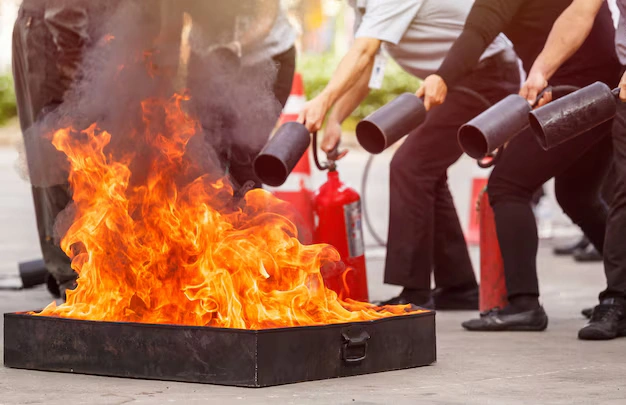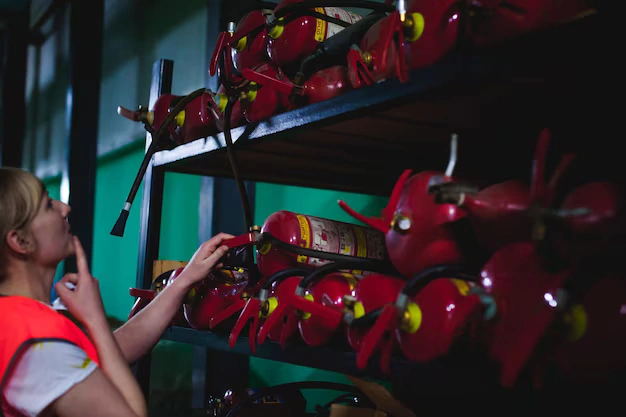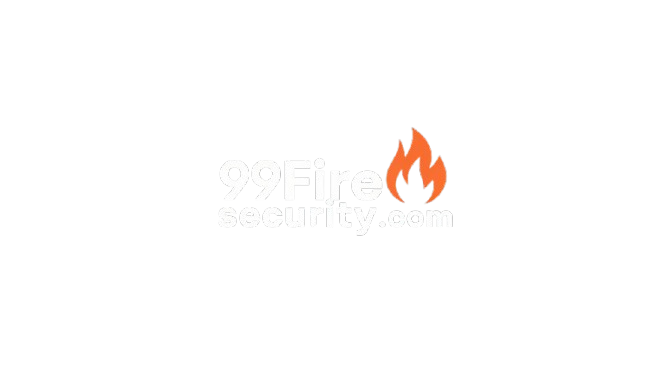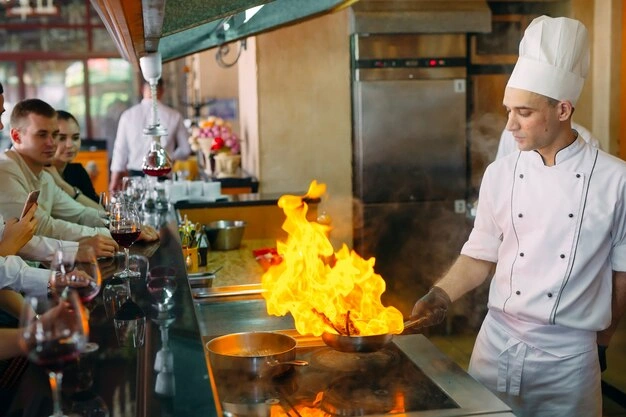Due to a high volume of people and the many different pieces of equipment used in the hospitality industry, hotels, restaurants, resorts, and event venues have unique fire risks. According to the U.S. Fire Administration, hotels and motels are responsible for an estimated 3,000 fires each year just in the U.S. Thus, efficient fire safety training for the hospitality industry employees is required to protect both guests and staff members during a fire emergency. This article will cover how to build a fire safety training that is hands-on, interesting, and extremely effective.

Assess the Specific Fire Risks in Your Establishment
Before starting fire safety training, it’s important to determine the fire risks that are specific to your hospitality business. Different types of hospitality facilities (hotel, restaurant, event space, etc.) have their own fire hazards depending on the equipment, layout, and guest volume. Recognizing these risks will help you adapt your training programs to address them. For instance, kitchen fires are common among restaurants, whereas hotels being are prone to electrical-related hazards and fires involving flammable materials like bedding and curtains.
Common Fire Hazards to Address:
- Kitchen Fires: The result of all the cooking oils, gas appliances, and deep fryers in restaurant kitchens.
- Electrical Fires: Due to bad wiring or overloaded circuits, hotels and resorts have risks.
- Flammable Materials: Venues for events and swing spaces may be more difficult to exit for a good number of people in a reasonable amount of time.
- Crowded Spaces: It could be difficult for banquet halls and event locations to quickly evacuate sizable crowds.
Develop a Comprehensive Fire Safety Training Program
By developing a thorough training program, you can better prepare your hospitality employees for a fire emergency. Program topics should range from fire prevention to evacuation policies to the use of fire extinguishers.
Key Training Topics to Include:
- Fire Prevention Measures: Train kitchen workers to use ovens, ovens, and deep fryers properly, and ensure they’re aware with kitchen fire conquest systems. Remind workers not to overload electrical routes and to store cleaning chemicals, paper products, and other incendiary items safely.
- Evacuation Procedures: All workers should be familiar with primary and secondary evacuation routes and know the locations of exits, emergency stairwells, and assembly points. Train staff to help guests during an evacuation, especially people with disabilities or mobility challenges.
- Using Fire Extinguishers: Demonstrate how to use fire extinguishers. Workers should be trained in the PASS method (Pull, Aim, Squeeze, Sweep) so that they feel comfortable using extinguishers in a real emergency.
- Fire Alarm and Notification Procedures: Employees should be trained in how to activate the fire alarm system and notify emergency services. Train staff to relay fire emergencies to guests in an orderly, calm manner.
- Basic First Aid for Fire-Related Injuries: You need to educate your group about what to do for burns, smoke inhalation, and other injuries due to fire. Staff members should be capable of providing assistance to injured people while waiting for medical aid.
Conduct Hands-On Training and Drills
The training should include practical, hands-on exercises that prepare employees to know what to do in the event of a fire emergency. For this reason, the FSP-trained data will help hospitality workers speed up and improve their response in a real fire.
Effective Training Practices:
- Fire Drill Simulations: Schedule and perform regular fire drills throughout the campus at various times and locations to review, adjust fire evacuation plans, and enhance readiness. As instances, consider faking kitchen fires, electrical fires, and more to ensure workers know what to do in a range of states.
- Fire Extinguisher Practice: Manner fire extinguisher training sessions that involve employees extinction small simulated fires using fire extinguishers. This will help develop assurance and muscle memory so you know how to use extinguishers if you ever need to.
- Evacuation Drills: Practice evacuation within the property. Staff should know their role, including assisting guests to safety, ushering them towards doors, and then tracking guests at the assembly point. Assumption of risk Budgeted for kayaks Rehearsal. Make drills as realistic as you can using real-life scenarios.
Use Engaging Training Materials
Use different types of fire safety training material to engage workers and accommodate different learning styles to allow workers to get the most out of fire safety training. Using a combination of visual, auditory, and hands-on training techniques can help make fire safety more approachable and memorable for all employees.
Effective Training Materials:
- Fire Safety Videos: We could show videos of common fire hazards, fire prevention techniques, and ways to respond during a fire emergency. Short videos show workers how to react in a fire situation.
- Posters and Signage: Create and display posters/evacuation maps/fire extinguisher location posters in common areas. With these visual aids, the fire safety measures and emergency equipment will become ingrained in the mind of the worker.
- Interactive Quizzes: Test workers’ knowledge about fire safety procedures with online quizzes or paper-based tests that follow training sessions. Interactive quizzes can help solidify key concepts and enable workers to show they understand the material.
- Handouts and Guides: These can include guides and bonuses that workers can refer to during an extra or as a refresher, such as clearing maps, emergency actions, and fire extinguisher guides.

Provide Ongoing Fire Safety Education
Fire safety is a lifelong work, not a one-off effort. Staying on top of fire safety training and offering refresher courses from time to time makes sure staff is ready for any kind of emergency. Also, this continual education helps ensure any new risks, changes in fire safety protocols, and updates to building layout are assessed to make sure none are going to pose a risk to fire safety.
Ongoing Training Ideas:
- Annual Refresher Courses: Provide refresher courses every year to reinforce fire safety concepts and keep your workers up to date on best practices.
- Regular Fire Safety Meetings: Hold monthly or quarterly fire safety meetings where workers can discuss fire drills, report concerns, and share feedback.
- Feedback and Improvement: Ask for feedback after every drill or real emergency about how the training can be improved. Conducting regular assessments can assist in determining any shortcomings in the training plan.
Evaluate the Effectiveness of Fire Safety Training
Just fire safety training is not enough; we must evaluate how ready the workers are for a real fire emergency. This helps guarantee that the training has been successful and that employees will be able to respond with confidence in a real emergency.

Evaluation Methods:
- Employee Feedback: Have some survey polls or discussion sessions to get the feedback from the employees regarding the training. Discover what they found helpful and what can be improved.
- Performance During Drills: You can also conduct fire drills and see how your workers perform. Do they know the most efficient way to get the building evacuated? Are they aware of how to properly use fire extinguishers?
- Assess Knowledge Retention: Assess if employees have retained the fire safety knowledge post the training with tests or quizzes. This will enable you to determine if your employees are well-equipped to handle fire incidents.
Conclusion
Why is fire safety training so crucial in the hospitality industry? By recognizing potential fire hazards, offering a detailed training program, and performing regular, ongoing education, hospitality establishments can develop a safer environment for everyone. Periodic fire safety training is also a way to keep check on compliance with fire safety regulations, lower the risk of accidents, and save lives. By placing emphasis and funding on fire safety training, you’re not only protecting your property but also protecting the lives of those you’re responsible for.
FAQs
- How often should fire safety training be conducted for hospitality workers?
Fire safety training is to be carried out every year, but refresher courses may be conducted if needed. - What should be included in a fire safety training session?
Proper fire prevention, evacuation procedures, fire extinguisher use, first aid for fire injury, alarm systems, fire safety training, etc. - How can fire safety training be made more engaging for hospitality workers?
And integrate interactive materials like videos, quizzes, and hands-on drills to keep workers engaged and reinforce the principles of fire safety. - What is the importance of fire drills in hospitality establishments?
Fire drills assist staff members in working evacuation actions, make them aware of how to use fire extinguishers, and will lessen their time to reply to a fire in situation of an emergency. - Are there specific fire safety regulations for the hospitality industry?
Yes, hotels are regulated under fire safety codes that require regular fire drills, checking fire equipment, and training staff for safety.


